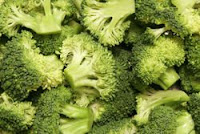
Try this three times before you say “No, thank you.”
“I do not like broccoli and I haven’t liked it since I was a little kid and my mother made me eat it. And I’m President of the United States and I’m not going to eat anymore broccoli,” said Father Bush as he stomped his foot and hit his fist on the podium during his inaugural speech.
OK, it wasn’t exactly like that, but he did raise a fist in defiance against broccoli, especially when the broccoli farmers taunted him with truckloads of those little leafy green trees.
Yea, we all have tales of woe over force fed vegetables.
For me it was succotash which my stepmother made me eat before being excused from the table. Ha ha, but I showed her when I spit it into a napkin and finally said at nine PM, “I’m done. May I be excused?”
I did not eat succotash again until I was in culinary school where I decided that I would overcome all of my childhood food phobias. I formed new and lasting relationships with Brussels sprouts and split peas too.
For those of you who “do not like broccoli” with as much passion as George abhorred it, please read on and give me a chance to persuade you otherwise.
Broccoli is member of the cruciferous or Brassica family, sharing lineage with cauliflower, collard greens, Brussels sprouts, cabbage, kale, radishes, horseradish, arugula, mustard, rutabagas, kohlrabi and turnips. With such a variety of tastes, textures and nutrients to offer, this is certainly a family tree worth climbing.
Research has shown that diets high in cruciferous vegetables are associated with lower incidences of certain cancers such as lung, colon, breast, bladder, prostate and ovarian cancer.
Cruciferous vegetables contain health-promoting phytonutrients, specifically sulforaphanes and indoles. Indoles help to increase production of a form of estrogen which may help to protect against cancer. Indoles also deactivate an estrogen byproduct which might otherwise promote tumor growth in breast cells. On the other hand, sulforaphanes boost the body’s detoxification enzymes which help to clear potential cancer-causing substances from the body more quickly.
Another protective piece of the broccoli puzzle is a compound called a glucosynolate. When Brassicas are cut or chewed, an enzyme converts glucosynolates into isothiocyanates which in turn help to protect against bladder cancer. Isothiocyanates are also classified as goitrogens, which are substances that can interfere with the function of the thyroid gland. However, this may only be problematic for people with pre-existing thyroid conditions.
So, for some people, isothiocyanates are protective whereas for others they may pose a problem, but even if you have a thyroid condition, the benefits of Brassicas far outweigh the risks. Simply keep your intake consistent and not excessive. This is also helpful advice for those who say crucifers cause gas. If you eat a little each day and not a lot at one time, it will be easier to tolerate these nutritious nibbles.
Cooking also makes crucifers easier to digest and may decrease isothiocyanate activity. Therefore, individuals with known thyroid problems might want to blanch their crucifers before consumption while individuals with a family history of bladder cancers may choose to go raw.
Crucifers are also rich in carotenoids which are sometimes more bioavailable when heated.
Vitamin C is also abundant in Brassicas. In the body, vitamin C hangs out in the watery moats where it surrounds and protects each delicate cell.
Vitamin C functions similarly in plants where it is found inside the water rich plant walls. When food is cut, water escapes along with that precious C. For that reason, the best advice is to use a good sharp knife to cut your food precisely and chew it thoroughly so that the cell membranes will rupture in your mouth, releasing as much protective C as possible.
That’s a lot of information so let’s sum it up with this colorful and tasty, crunchy cruciferous treat. It’s all in there, I promise.
Cruciferous Crunch
1 bunch Broccoli, diced, florets & stems (~4 cups total)
¼ red onion, fine dice
½ cup walnuts, chopped
½ cup dried cranberries (or raisins)
Dressing:
2 Tablespoons Canola based mayo
1/2 cup Lowfat Organic Yogurt
1 Tbsp Apple Cider Vinegar
1 Tbsp Honey
¼ tsp Cayenne Pepper
¼ tsp sea salt
Cut the florets and stems into 1/2 inch pieces (remove one inch from the end of the stalks and discard)
To Blanch Broccoli: Boil water in a sauce pot. Throw the broccoli in the water then immediately remove from heat and rinse in a colander under cold running water to stop the cooking process. Refrigerate to chill. Combine dressing ingredients in a large bowl and mix with a fork. Add the chopped broccoli, onion, walnuts and cranberries. Mix well. Serve on a bed of greens and top with tofu, shrimp or free range chicken.

